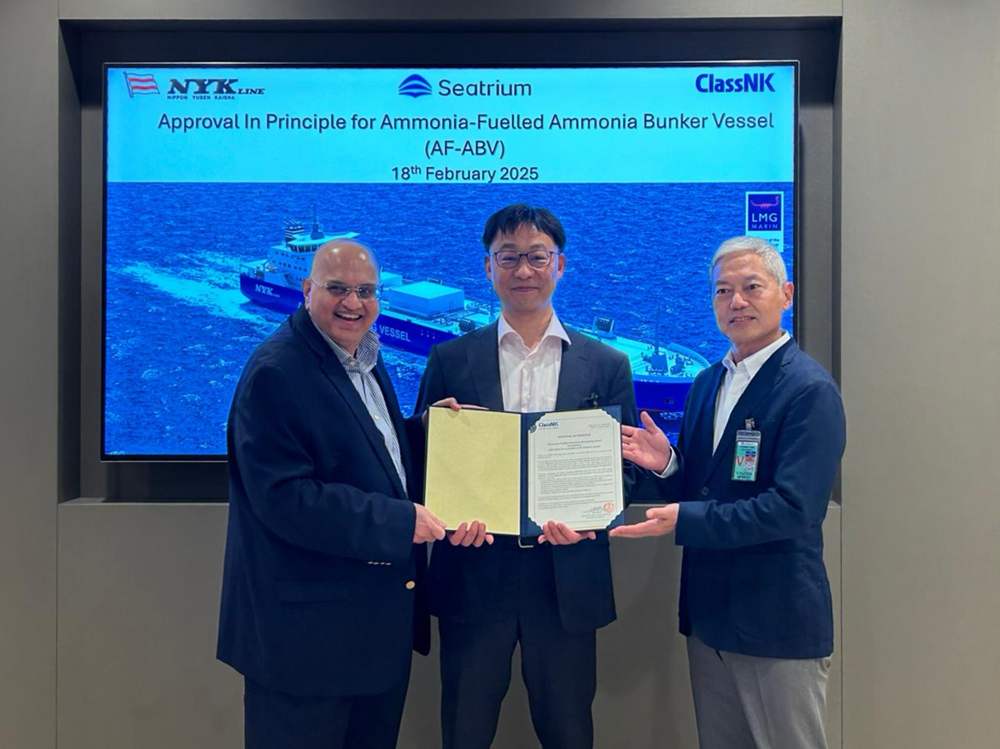A significant breakthrough in the transition to sustainable maritime energy has been achieved with the issuance of an Approval-in-Principle (AiP) certificate for an ammonia-fueled bunkering vessel.
This milestone marks the outcome of a collaborative effort between Nippon Yusen Kabushiki Kaisha (NYK) and its partners. Seatrium, through its subsidiary LMG Marin, provided essential engineering expertise in designing the vessel, which will now undergo evaluation by the Maritime and Port Authority of Singapore (MPA).
This initiative aims to address the urgent need for the maritime industry to decarbonize and develop a viable ammonia-based fuel supply chain. The project highlights the consortium’s commitment to fostering a greener and more sustainable maritime future.
Leading the Green Transition
The AiP certification confirms that the ammonia-fueled bunkering vessel design meets rigorous safety, technical, and environmental standards, establishing the consortium as a pioneer in alternative fuels for the maritime sector. By advancing the feasibility of ammonia as a viable marine fuel, this project positions the consortium at the forefront of the maritime energy transition.
Tsutomu Yokoyama, Executive Officer at NYK Line, remarked, “The Approval-in-Principle is a pivotal step in our efforts to fast-track the adoption of clean ammonia as a sustainable marine fuel. With the deep ammonia expertise of NYK and our partners, combined with Seatrium’s technical capabilities, we are setting new standards for safety and efficiency while paving the way for a cleaner maritime industry.”
LMG Marin’s Role in Engineering Innovation
Seatrium’s technology arm, LMG Marin, played a key role in the consortium’s initiative by leveraging its extensive expertise in designing complex maritime systems. LMG Marin led the Hazard Identification Study (HAZID) to validate the vessel’s design, fulfilling AiP requirements and ensuring optimal safety, performance, and operational reliability. During the concept design phase, safety strategies for the safe use of ammonia in fuel-powered engines were developed in compliance with the International Maritime Organization’s (IMO) interim guidelines for ammonia-fueled ships, approved by the Maritime Safety Committee in December 2024.
The vessel design also incorporates two crucial technologies: ammonia dual-fuel engines from IHI Power Systems and a bunkering boom developed by TB Global Technologies. These engines, which significantly reduce greenhouse gas emissions, are already in operation on the world’s first ammonia-fueled commercial tugboat, Sakigake, delivered in August 2024. The bunkering boom features the High-Speed Ammonia Purging Emergency Release System (ERS), which ensures safe and efficient vessel disconnections in emergency situations.
Aziz Merchant, Executive Vice President for Engineering, Technology & New Product Development at Seatrium and Chairman of LMG Marin, stated, “We are proud to support this ground-breaking project led by NYK and its partners. The use of ammonia as a non-fossil-based marine fuel is a critical innovation. Our collaboration reaffirms Seatrium’s dedication to advancing sustainability and driving global decarbonization goals.”
A Step Forward for Singapore and Maritime Innovation
The ammonia-fueled bunkering vessel design will be submitted to the MPA for further evaluation, showcasing Singapore’s role as a global leader in sustainable maritime solutions. If realized, this vessel will be the first of its kind and will play a key role in Singapore’s marine decarbonization efforts, creating a positive ripple effect across the global shipping industry. The design is also a vital step in developing ammonia bunkering infrastructure—an essential component of reducing greenhouse gas (GHG) emissions in international shipping.




